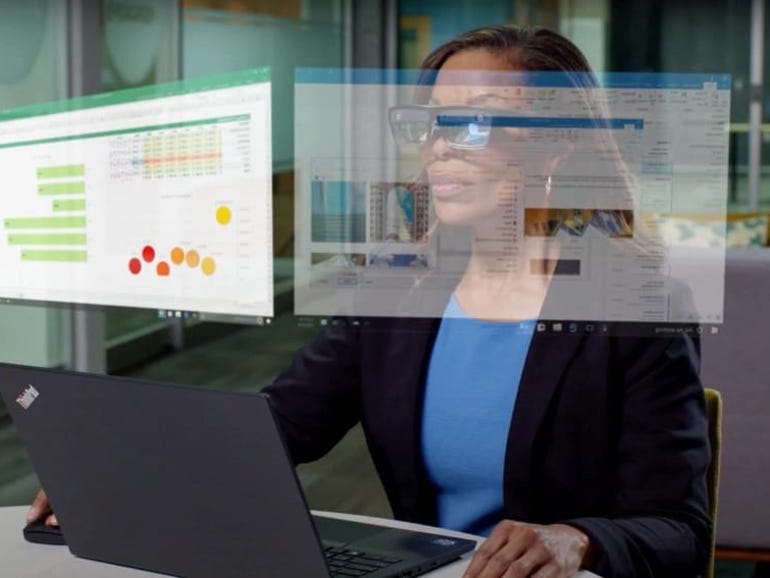In my last column, I discussed how Lenovo’s ThinkReality A3 works with select models of the company’s Motorola smartphones to provide an unbounded, high-quality AR experience. The A3, though, is just one in a line of AR and VR headsets from Lenovo and partners (such as the monocular headset from RealWare) that the company is leveraging to create managed edge solutions for mixed reality. In doing so, it offers the broadest portfolio of wearable options (although competitors such as HP have worked to close the VR sensory loop with its Reverb 2, Omnicept edition). In doing so, Lenovo is simultaneously trying to create a big tent to meet a range of customer demands while driving integration with its own products.
For that latter aim, the PC is a natural starting point. As I wrote, the A3 on the PC acts more like an accessory than as the independent device experience with its own user interface that Lenovo offers on the smartphone. There are opportunities for PC-based AR functionality more like what Lenovo has delivered on the smartphone. But with the A3s being based on the XR1 reference design developed by Qualcomm, it’s no surprise that smartphone integration was a higher priority out of the gate.
Lenovo offers Windows-based display configuration software that offers many options for controlling the A3’s virtual displays, including their resolution, scale, and perceived distance from each other and the wearer, i.e., depth. While Lenovo has developed a clever way to manage the cursor transition between a PC’s physical display and the A3 virtual displays via the PC software, it’s a conceptual departure from the everyday use of multiple monitors that requires even more focus-shifting than the standard multiple monitor approach.
As the company notes, the A3’s virtual displays offer benefits that include enhanced security (no over-the-shoulder snooping) and space and weight savings versus transporting multiple displays; the potential of these benefits multiplies as you increase the number of displays. Indeed, the A3s come with a protective case that’s only about twice the size of a standard eyeglass case, far smaller than even a single portable 13″ monitor. Beyond this, virtual displays offer some advantages that would be challenging or impossible for physical monitors, such as being able to stack displays on the fly or change their curvature with the drag of a cursor.
The option represents a step forward in using AR for traditional application productivity. However, while using the A3s provides a taste of how today’s computing paradigms may migrate to a screen-free future, there are a few limitations of the early implementation. First, while the A3 can provide vibrant 3D holograms on a midrange Motorola smartphone, tapping the virtual display feature requires a workstation-class PC with discrete graphics such as Lenovo’s ThinkPad P series.
Second, I struggled with a “Goldilocks problem” with the virtual displays. Making them too large required excessive head movement to keep them in the A3’s field of view. But making them small enough to minimize such movements made it difficult to view and select text and small interface elements. Opting for a single ultrawide virtual display (at 3840×1920 resolution) instead of multiple monitors helped by removing the wasted space between the virtual displays. Overall, though, the A3’s virtual display feature represents a better fit for tasks such as visually contrasting design models versus manipulating Excel spreadsheets. Lenovo offers that getting the hang of navigating the displays may require more acclimation.
The experience also reflects yet another missed opportunity resulting from Microsoft’s failure to produce a touch-friendly interface since, as the A3’s smartphone experience shows, the finger-friendliness of controls in such an interface also provides easier interface targets in the less-precise navigation of augmented reality. While Lenovo should explore a middle-ground interface between virtual display extension and the full smartphone interface, the addition of more Android app options for Windows should provide a bridge between the A3’s smartphone and PC feature set. Longer term, the PC-based experience would particularly benefit from increasing the glasses’ limited field of view. This is a common shortcoming of early AR headsets, but one on which the industry is making progress amidst competing priorities such as resolution and power consumption.
When it comes to 3D object viewing and manipulation or even operating 2D Android apps in open space, the ThinkReality A3’s smartphone option is a comfortable, effective, and reasonably mobile option that has a clear ROI case. For most users looking to move beyond a single display, though, a portable second monitor remains a simpler and more practical option–even for those whose PCs have the horsepower to project output out into space and the future.
For all the latest Technology News Click Here
For the latest news and updates, follow us on Google News.

